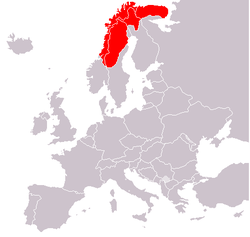Sapmi
 Sápmi in Europe |
|
| National anthem | Sámi soga lávlla (Song of the Sami people). |
| National day | 6 February (Sami National Day). |
| Languages | Sami languages, Norwegian, Swedish, Finnish, Meänkieli, Kven, Russian |
| Area | Approx. 400,000 km2 (150,000 sq mi) |
| Population | About 2,000,000 total
* = Includes minorities. |
| Independence | None¹ |
| Time zone | UTC +1 to +3 |
| ¹ Integrated parts of Norway, Sweden, Finland and Russia respectively, but with varying degrees of autonomy for the Sami population. | |
* = Includes minorities.
Sápmi (Northern Sami: [ˈsaʔmi]), in English commonly known as Lapland (/ˈlæplənd/), is the cultural region traditionally inhabited by the Sami people, traditionally known in English as Lapps. Sápmi is located in Northern Europe and includes the northern parts of Fennoscandia. The region stretches over four countries: Norway, Sweden, Finland, and Russia. On the north it is bounded by the Barents Sea, on the west by the Norwegian Sea and on the east by the White Sea.
Russians and Norwegians are the most numerous groups in the region; the Sami make up only a small minority of about 5% of the population in Sápmi. No political organization advocates secession, although several groups desire more territorial autonomy and/or more self-determination for the region's indigenous population.
Sápmi (and corresponding terms in other Sami languages) refers to both the Sami land and the Sami people. In fact, the word "Sámi" is only the accusative-genitive form of the noun "Sápmi"—making the name's (Sámi olbmot) meaning "people of Sápmi." The origin of the word is speculated to be related to the Baltic word *žēmē that simply means "land". The same word is speculated to be the origin of "Suomi", the Finnish name for Finland.
Sápmi is the name in North Sami, while the Julev Sami name is Sábme and the South Sami name is Saemie. In Norwegian and Swedish the term Sameland is often used.
...
Wikipedia

